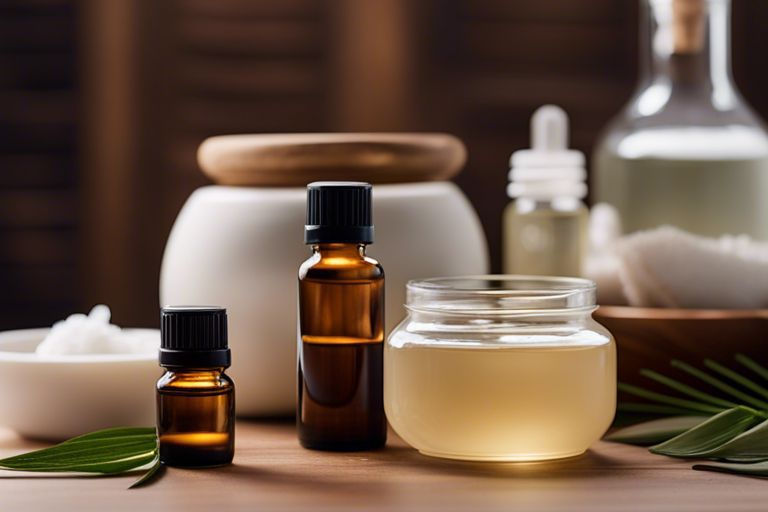Are you looking to harness the benefits of essential oils, but find them too potent in their pure form? How to Dilute Essential Oils with Coconut Oil is a question but can it be a safe and effective way to enjoy their therapeutic properties without causing any irritation or adverse reactions?
This method is particularly important for those with sensitive skin, as undiluted essential oils can be highly concentrated and potentially harmful. By following the right dilution ratios and techniques, you can create your own customized blends that are safe for topical application.
In this blog post, we’ll guide you through the process of diluting essential oils with coconut oil and provide you with essential tips to ensure your safety and satisfaction.
Benefits to Dilute Essential Oil with coconut oil
While essential oils are highly concentrated and powerful substances, they should never be used undiluted on your skin. That’s why it’s important to dilute them with a carrier oil like coconut oil before applying them topically.
Dilution not only helps to minimize the risk of skin irritation, but it also allows you to cover a larger surface area with the essential oil without using too much of the concentrated oil. This chapter will cover the basics of diluting essential oils with coconut oil, including dilution ratios and the tools and supplies you will need.
Dilute Essential Oil with coconut oil for Hair Care:
Discover the benefits of combining essential oils with coconut oil for healthier hair. Tailor your blend for growth, addressing specific concerns, or overall nourishment. Mix a few drops of essential oil with a tablespoon of coconut oil, choosing oils based on your hair type and needs.
Also Read : Best way to dilute essential oils for hair
Dilute Essential Oil with coconut oil for Skin Care:
Enhance your skincare routine with diluted essential oils in coconut oil. Create a personalized blend for your skin type, using coconut oil as a base. For a general facial oil, mix coconut oil with essential oils like lavender, chamomile, or rosehip. Adjust ratios based on your skin’s needs.
Also Read: Best way to dilute Coconut essential oils for skin
Dilute Essential Oil with coconut oil for Face Care:
Elevate your facial skincare with essential oils and coconut oil. Customize blends with oils such as frankincense for anti-aging, rose for hydration, or chamomile for soothing. Create a rejuvenating night treatment with coconut oil and lavender or ylang-ylang for daytime freshness.
Also Read: How to Dilute Essential Oils with Coconut Oil for Face? Perfect Ratio !
Frankincense Blend with coconut oil:
Explore the synergy of frankincense and coconut oil. Mix a few drops of frankincense with coconut oil for an anti-inflammatory, anti-aging skincare blend. Use it as a facial moisturizer or for targeted skin concerns. Create a calming massage oil with equal parts frankincense and coconut oil for relaxation. Experiment to find your perfect blend.
Also Read : Best way to Mix Frankincense with Coconut Oil? Step-by-Step Guide !
Dilution Ratios Explained
When it comes to diluting essential oils with coconut oil, it’s important to understand the concept of dilution ratios. A general rule of thumb is to use a 2% dilution, which means adding 12 drops of essential oil to every 1 ounce (30ml) of carrier oil.
For children, elderly individuals, or those with sensitive skin, it’s recommended to use an even lower dilution of 1% or less. Keep in mind that some essential oils require even lower dilutions, so it’s crucial to research each oil before diluting it.
Tools and Supplies Needed
Before you start diluting essential oils with coconut oil, you’ll need to gather a few essential tools and supplies. You will need amber glass bottles to store your diluted essential oil blends, a carrier oil such as coconut oil, and essential oils of your choice.
Additionally, having a set of measuring spoons and a small funnel can make the dilution process much easier and more precise. It’s important to use dark glass bottles to store your diluted essential oil blends as they help protect the oils from light and air exposure, prolonging their shelf life.
Step-by-Step Guide to Diluting Essential Oils with Coconut Oil
Keep in mind that diluting essential oils with a carrier oil such as coconut oil is crucial to prevent skin irritation or sensitization. Here is a step-by-step guide to help you properly dilute essential oils with coconut oil. For a more comprehensive guide on essential oil dilution, you can also refer to How to Dilute Essential Oils: A Comprehensive Guide.
Preparing Your Workspace
Before you start diluting essential oils with coconut oil, it’s important to prepare your workspace. Choose a clean, flat surface to work on and gather all the necessary supplies including dark glass bottles, measuring spoons, and a stirring rod. Make sure that your hands and all the equipment you will be using are clean to avoid contamination.
Mixing Essential Oils and Coconut Oil
When mixing essential oils with coconut oil, always remember that the concentration of essential oils should be kept at a safe level to avoid any adverse reactions. As a general guideline, it’s recommended to use a 2% dilution, which means adding 12 drops of essential oil to 1 ounce (30 ml) of coconut oil. You can refer to the table below for a quick reference on essential oil dilution ratios.

Additional Tips and Uses
Your diluted essential oil blend can be used in a variety of ways beyond just applying it to your skin. Consider adding a few drops to your favorite unscented lotion or body oil to create a custom scented product.
You can also add a few drops to a cotton ball and place it in a drawer to infuse your clothes with a lovely scent. Another idea is to mix it with water in a spray bottle and use it as a natural air freshener for your home. The possibilities are endless when it comes to using your diluted essential oils.
- Experiment with different essential oil combinations to find your favorite scent
- Use your diluted blend in a diffuser to enjoy the aromatherapy benefits
- Consider adding a few drops to your bathwater for a relaxing soak
This way, you can find the options that work best for you and your lifestyle.
Storage and Shelf Life
Proper storage of your diluted essential oil blend is essential to ensure it stays effective and safe to use. Keep it in a cool, dark place, away from direct sunlight and heat. Make sure it is in a dark glass bottle to prevent exposure to light, which can cause the oil to degrade. When stored properly, your diluted blend should have a shelf life of about six months to a year, depending on the type of essential oil used.
Creative Uses for Your Diluted Essential Oil Blend
In addition to using your diluted essential oil blend for skincare and aromatherapy, there are many other creative uses for it. For example, you can add a few drops to a pot of boiling water and inhale the steam to help clear your sinuses.
You can also use it as a natural insect repellent by dabbing it on pulse points or mixing it with a carrier oil and applying it to your skin. Get creative and explore the various ways you can incorporate your diluted essential oils into your daily routine.
Safety Considerations
When it comes to using essential oils, safety should be your top priority. While these oils offer numerous benefits, they can also pose risks if not used properly. Essential oils are highly concentrated and should never be applied directly to the skin without being diluted with a carrier oil, such as coconut oil.
Additionally, some essential oils can cause skin sensitivities or allergic reactions, so it’s essential to perform a patch test before using them on larger areas of your skin. Keep in mind that essential oils should not be ingested without the guidance of a qualified aromatherapist or healthcare professional.
It’s also important to store essential oils out of reach of children and pets, as ingestion can be harmful. Always follow the recommended dilution ratios and usage guidelines for each essential oil to ensure a safe and enjoyable experience.

Conclusion
Drawing together all the information provided, diluting essential oils with coconut oil is a simple yet crucial step to ensure safe and effective use of essential oils on your skin. By following the recommended dilution ratios and mixing techniques, you can enjoy the benefits of essential oils without risking any adverse reactions.
Remember to always perform a patch test before using the diluted blend on a larger area of your skin, and consult a qualified aromatherapist or healthcare professional for specific guidance on dilution ratios for different essential oils. With the right knowledge and precautions, you can confidently incorporate essential oils into your daily self-care routine.
FAQ
Q: Why should I dilute essential oils with coconut oil?
A: Essential oils are highly concentrated and can cause skin irritation or other adverse reactions if applied directly. Diluting them with a carrier oil like coconut oil helps to reduce the risk of irritation and allows for safer application to the skin.
Q: What is the recommended dilution ratio for essential oils and coconut oil?
A: The general rule of thumb for diluting essential oils with coconut oil is to use a 2% dilution, which means adding 12 drops of essential oil to every 1 ounce (30ml) of coconut oil. However, this ratio can be adjusted based on individual sensitivity and the specific essential oil being used.
Q: Can I use any type of coconut oil for diluting essential oils?
A: It is recommended to use unrefined, virgin or extra-virgin coconut oil for diluting essential oils, as these types of coconut oil retain more of their natural benefits and have a better scent. Refined coconut oil may contain additives and have a less appealing aroma.
Q: How should I mix essential oils with coconut oil?
A: To mix essential oils with coconut oil, simply add the desired amount of coconut oil into a clean, dry container and then add the appropriate number of drops of essential oil. Mix well to ensure the essential oil is evenly distributed throughout the coconut oil.
Q: Are there any essential oils that should not be diluted with coconut oil?
A: Some individuals may have allergies or sensitivities to specific essential oils or carrier oils, so it is important to perform a patch test before applying any diluted essential oils to larger areas of the skin. Additionally, some essential oils may have specific dilution recommendations due to their potency, so it’s important to research each oil before diluting it with coconut oil.


1 Comment
[…] Explore: How to Dilute Essential Oils with Coconut Oil? […]